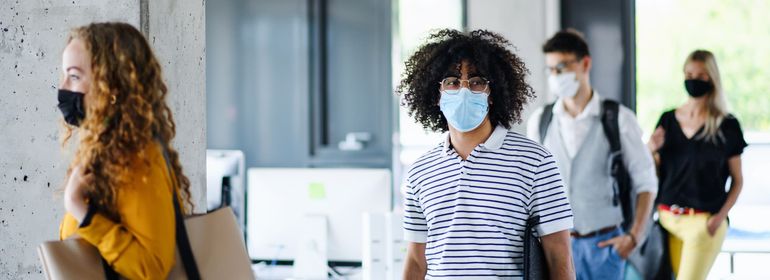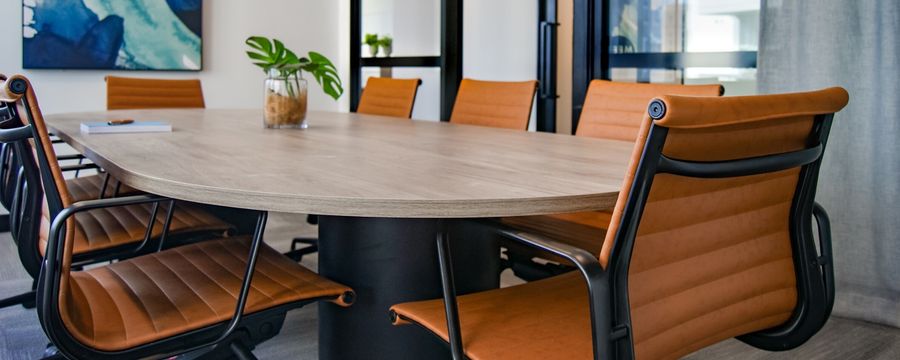Workplace managers, office managers, and facilities team are at the front lines of dealing with the COVID-19 health crisis at the workplace. US Occupational Safety and Health Administration (OSHA) has rolled out detailed guidelines for preparing for COVID-19, especially as employees return from working from home environment and quarantine lockdowns. Here is a quick summary of the guidelines that will help workplace teams implement processes safely.
Here is the complete report for further reading
OSHA Homepage for COVID19 response
Companies should prioritize putting together a pandemic response plan that includes detailed mesaures and processes for engineering and administrative departments, as well as Personal Protective Equipment (PPE). I will talk about each of those in some detail below.
How COVID-19 Spreads
The virus spreads primarily through person-to-person contact when you are within six feet of another person. COVID-19 can also spread through respiratory droplets produced by an infected person who coughs or sneezes. It’s also possible to spread the virus by touching a surface or object with the virus on it and then touching your mouth, nose, or eyes.
Implement Basic Infection Prevention Measures
- Promote frequent hand washing: Post clear reminders and informational messages throughout restrooms, kitchens, and common areas. Also, provide specific guidance around hand washing areas to employees, customers and visitors. Place hand sanitizers wherever hand washing is not available. Also provide clear call-to-action for visitors to sanitize their hands.
- Eliminate handshakes in the workplace: Encourage employees to use alternative greetings to prevent awkward social interactions. Place signs that encourage elbow shake, namaste, bow, and newer creative ways of touchless greetings.
- Ensure there are tissue and trash receptacles.
- Promoting remote work, work from home, and flexbile work hours that increase physical distance among people.
- Discourage use of other people’s phones, desks, offices, and other tools as much as possible.
- Set up regular and more frequent housekeeping practices: Ensure the office is cleaned every day. Encourage employees to routinely clean their workspaces and disinfecting sprays and wipes.
Develop Policies and Procedures for Prompt Idenfication and Isolation of Sick People
- Inform and encourage employees to self-monitor their symptoms. Strong recommendation to ask people to take time off and work from home if they are showing symptoms.
- Write a policy for employees to report if they are experiencing COVID-19 symptoms.
- Have a process in place for quickly isolating people who show signs of COVID-19.
- Provide face masks to infected employees to quickly limit the spread of COVID-19.
Develop and Expand Flexible Work Policies
- Actively encourage six people to stay at work.
- Ensure that your sick leave policies are flexible.
- Allow employees to stay at home and take care of family members who might be sick.
Engineering Controls
Engineering controls. These engineering controls isolate employees from work related hazards. Some of the techniques involve the following:
- Instal high-efficiency air filters
- Increase ventilation rate in the workplace
- Provide masks and sneeze guards and tissues
- Corona virus can last on stainless steel for upto 72 hours. Avoid commonly touched surface areas. E.g. Automated trash receptacles and touchless door unlock systems (e.g. Swiftlane)
- Reduce contact to commonly touched surface areas such as meeting rooms, telephones, etc.
Adminstrative Controls
- Encourge sick workers to stay at home
- Minimize contact among workers, clients, and customers by moving to virtual meetings
- Reduce the total number of workers in the office by increasing shifts, alternating shifts, etc.
- Discontinue non-essential travel
- Develop and share emergency communication plans, including a group chat/forum for employees to ask for guidance and questions around COVID-19
- Provide up-to-date education and training on risk factors and protective behaviors
- Train first responders on how to put on a mask, wear it correctly to improve safety when near a person showing symptoms
- Provide resources and work environments that encourage personal hygiene. Provide tissues, touchless trash cans, touchless doors, hand soap, alcohol-based hand rubs, and disposable towels.
Here are some posters from CDC you can print and post in your office Here is a poster from CDC around slowing the spread of germs
Personal Protective Equipment (PPE)
Examples of PPE include gloves, masks, and face sheilds. Please note that employers are required to provide PPE to employees to keep them safe while performing their duties. The level of equipment you provide depends on the risk level of the employees’ role.
- All PPE should be provided based on the level of risk, toward exposure to a COVID-19 infected person. E.g. In the workplace, you might want to provide the receptionist with a face mask and hands sanitizer.
- All PPE should be regularly inspected, maintained and replaced as needed. Establish a schedule to review supplies and procedures around restocking PPE as needed for your company.
- If a person is working within six feet of known or suspected patients, they need to be provided respirators. Please see the official guidance for detailed information linked above.
The workplace managers, office managers, and facilities teams are at the front lines of dealing with the COVID-19 health crisis at the workplace. Having a well-written and clearly communicated plan is going to be critical in maintaining the health and safety of employees, contractors, and visitors.




